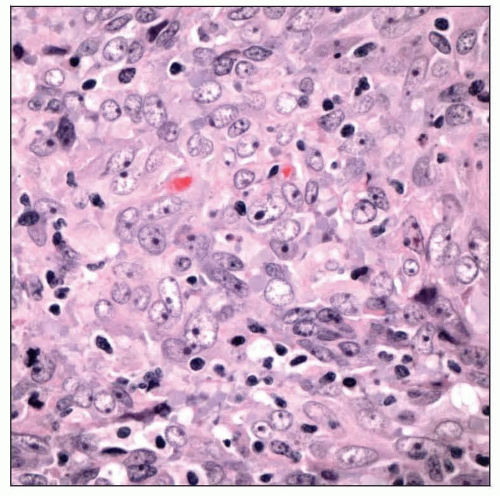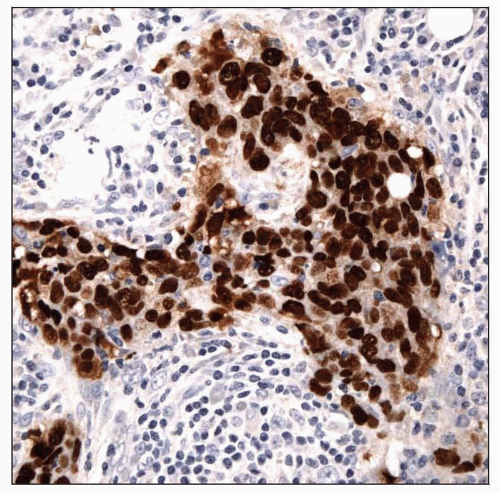Lymphoepithelial Carcinoma
Bruce M. Wenig, MD
Key Facts
Terminology
Undifferentiated carcinoma with associated prominent nonneoplastic lymphoplasmacytic cell infiltrate
Etiology/Pathogenesis
Etiology linked to Epstein-Barr virus (EBV)
Near 100% association in patients in endemic areas; in nonendemic areas, EBV usually absent
Clinical Issues
Predilection for Arctic region natives (Eskimos/Inuits from Alaska, Canada, Greenland), southeastern Chinese, and Japanese
Parotid gland most common site of occurrence (80%)
Combined (multimodality) therapy treatment of choice (surgical resection, neck dissection, radiation therapy)
5-year survival rate: 75-85%
Microscopic Pathology
Infiltrative tumor characterized by polygonal to spindle-shaped cells with large round to oval, basophilic to vesicular-appearing nuclei separated or overrun by nonneoplastic lymphoid stroma
Ancillary Tests
Cytokeratins, epithelial membrane antigen (EMA), p63 positive
EBER nearly always positive (endemic cases)
 The neoplastic cells are characterized by enlarged nuclei with vesicular chromatin, prominent nucleoli, and indistinct borders, the latter creating a syncytial pattern of growth. |
TERMINOLOGY
Abbreviations
Lymphoepithelial carcinoma (LEC)
Synonyms
Undifferentiated carcinoma
Lymphoepithelioma-like carcinoma
Lymphoepithelial-like carcinoma
Undifferentiated carcinoma with lymphoid stroma
Malignant lymphoepithelial lesion
Carcinoma ex lymphoepithelial lesion
Definitions
Undifferentiated carcinoma with associated prominent nonneoplastic lymphoplasmacytic cell infiltrate
ETIOLOGY/PATHOGENESIS
Infectious Agents
Etiology linked to Epstein-Barr virus (EBV)
Near 100% association in patients in endemic areas
In nonendemic areas, EBV usually absent but rarely may be identified
Presence of EBV in clonal episomal form suggests role in tumor development
Familial
Inherited trichoepitheliomas reported in setting of LEC suggesting hereditary predisposition
CLINICAL ISSUES
Epidemiology
Incidence
Rare salivary gland tumor accounting for < 1% of all salivary gland tumors
Highest incidence worldwide in Eskimo/Inuit population
Age
Occurs over wide age range with most patients in 5th decade of life
Gender
In Eskimos/Inuits, more common in females
Ethnicity
Predilection for Arctic region natives (Eskimos/Inuits from Alaska, Canada, Greenland), southeastern Chinese, and Japanese
Site
Parotid gland most common site of occurrence (80%) followed by submandibular gland
Rare occurrence in minor salivary glands throughout upper aerodigestive tract
Presentation
Mass swelling with or without associated pain &/or facial nerve paralysis
Fixation to skin &/or underlying structures seen in advanced tumors
High frequency (10-40%) of concurrent cervical lymphadenopathy
Laboratory Tests
Elevated anti-EBV viral capsid antigen IgA, anti-EBV nuclear antigen IgG in patients from endemic regions
Natural History
Most develop de novo but may arise in association with lymphoepithelial sialadenitis
No known association with other autoimmune disorders
e.g., Sj#ogren disease
Treatment




